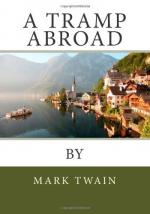Every few hundred yards, at particularly bad places, one came across a panel or so of plank fencing; but they were always old and weak, and they generally leaned out over the chasm and did not make any rash promises to hold up people who might need support. There was one of these panels which had only its upper board left; a pedestrianizing English youth came tearing down the path, was seized with an impulse to look over the precipice, and without an instant’s thought he threw his weight upon that crazy board. It bent outward a foot! I never made a gasp before that came so near suffocating me. The English youth’s face simply showed a lively surprise, but nothing more. He went swinging along valleyward again, as if he did not know he had just swindled a coroner by the closest kind of a shave.
The Alpine litter is sometimes like a cushioned box made fast between the middles of two long poles, and sometimes it is a chair with a back to it and a support for the feet. It is carried by relays of strong porters. The motion is easier than that of any other conveyance. We met a few men and a great many ladies in litters; it seemed to me that most of the ladies looked pale and nauseated; their general aspect gave me the idea that they were patiently enduring a horrible suffering. As a rule, they looked at their laps, and left the scenery to take care of itself.
But the most frightened creature I saw, was a led horse that overtook us. Poor fellow, he had been born and reared in the grassy levels of the Kandersteg valley and had never seen anything like this hideous place before. Every few steps he would stop short, glance wildly out from the dizzy height, and then spread his red nostrils wide and pant as violently as if he had been running a race; and all the while he quaked from head to heel as with a palsy. He was a handsome fellow, and he made a fine statuesque picture of terror, but it was pitiful to see him suffer so.
This dreadful path has had its tragedy. Baedeker, with his customary over-terseness, begins and ends the tale thus:
“The descent on horseback should be avoided. In 1861 a Comtesse d’Herlincourt fell from her saddle over the precipice and was killed on the spot.”
We looked over the precipice there, and saw the monument which commemorates the event. It stands in the bottom of the gorge, in a place which has been hollowed out of the rock to protect it from the torrent and the storms. Our old guide never spoke but when spoken to, and then limited himself to a syllable or two, but when we asked him about this tragedy he showed a strong interest in the matter. He said the Countess was very pretty, and very young—hardly out of her girlhood, in fact. She was newly married, and was on her bridal tour. The young husband was riding a little in advance; one guide was leading the husband’s horse, another was leading the bride’s.
The old man continued:




